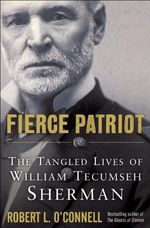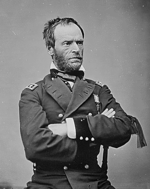by Eric Byrd
Have you ever seen Sherman? It is necessary to see him in order to realize the Norse make-up of the man – the hauteur, noble, yet democratic: a hauteur I have always hoped I, too, might possess. (Whitman)
 Abraham Lincoln, Ulysses Grant and William Tecumseh Sherman are the conspicuous figures in the revolutionary re-founding of the United States. The victory of which they were the grand strategists and the most acclaimed media actors seemed to decide some of the fundamental questions the Founders had left to ambiguous laws and a faith in future compromise; a victory that eased, though it did not resolve, the existentially divisive “Negro Question” James Madison noted at the Constitutional Convention of 1787: “the States were divided into different interests not by their difference of size, but principally from their having or not having slaves. [Difference] did not lie between the large and small States: it lay between the Northern and Southern.”
Abraham Lincoln, Ulysses Grant and William Tecumseh Sherman are the conspicuous figures in the revolutionary re-founding of the United States. The victory of which they were the grand strategists and the most acclaimed media actors seemed to decide some of the fundamental questions the Founders had left to ambiguous laws and a faith in future compromise; a victory that eased, though it did not resolve, the existentially divisive “Negro Question” James Madison noted at the Constitutional Convention of 1787: “the States were divided into different interests not by their difference of size, but principally from their having or not having slaves. [Difference] did not lie between the large and small States: it lay between the Northern and Southern.”
In his essential orations – the Gettysburg Address, the Second Inaugural Address – Lincoln is a civic priest or poet, rhetorical guardian, keeper of ideals whose phrasemaking points to a transcendental order. He promised Americans that though their republic had collapsed in an orgy of violence, their ideals were imperishable, and waited be reborn from the bloody struggle. Grant, ancestor of all our taciturn gunslingers and laconic detectives, is the heroic everyman, the homely knight, the General-in-Chief who wore a private’s blouse in the field and appeared apolitical, ambitious of nothing beyond speedy victory, and so able to allay Americans’ traditional republican fear that a powerful general is a potential dictator.
 Sherman is the scourge, the eccentric terror. The harsh style of his widely reprinted reports and official letters provided the public with a “vocabulary of the drastic,” wrote Charles Royster, and ensured that to many Unionists “his public character embodied the severity needed for the crushing of the rebellion.” He embodies that severity still, reduced to a now nearly anonymous aphorism (“War is Hell”), to the cinematic image of Atlanta in flames, and to the famous Matthew Brady portrait that made Evan S. Connell think of a “vulture with scrofula.” Of course Sherman, like Lincoln and Grant, is far more than his image, and a deeper study of the man is essential for the student of America’s consolidation and expansion. Sherman is one member of the late nineteenth century power elite who will tell you how the sausages were made, and in prose of nervous vehemence, half despairing, half gloating, with that note of philosophic detachment that creeps into discussions of the inevitable. He could also wax lyrical; the Mississippi River was to him a national Tree of Life, and he reminded a New Orleans correspondent that the city was
Sherman is the scourge, the eccentric terror. The harsh style of his widely reprinted reports and official letters provided the public with a “vocabulary of the drastic,” wrote Charles Royster, and ensured that to many Unionists “his public character embodied the severity needed for the crushing of the rebellion.” He embodies that severity still, reduced to a now nearly anonymous aphorism (“War is Hell”), to the cinematic image of Atlanta in flames, and to the famous Matthew Brady portrait that made Evan S. Connell think of a “vulture with scrofula.” Of course Sherman, like Lincoln and Grant, is far more than his image, and a deeper study of the man is essential for the student of America’s consolidation and expansion. Sherman is one member of the late nineteenth century power elite who will tell you how the sausages were made, and in prose of nervous vehemence, half despairing, half gloating, with that note of philosophic detachment that creeps into discussions of the inevitable. He could also wax lyrical; the Mississippi River was to him a national Tree of Life, and he reminded a New Orleans correspondent that the city was
the root of a tree whose branches reach the beautiful fields of western New York, and the majestic cañons of the Yellowstone, and that with every draught of water you take the outflow of the pure lakes of Minnesota and the dripping dews of of the Alleghany and Rocky Mountains.
He was subject to bouts of depression and reread Shakespeare constantly; he ends his memoirs with lines from Jaques’ melancholic soliloquy. He was prominent in the ruin of the rebellious slaveholders and the destruction of the nomadic tribes that hunted on the Great Plains; and for someone perched on the usually euphemistic heights of American power, he was villainously candid about the requisite violence and terror, and he was full of personal paradoxes.
Read more »
The idea of paradise is no longer imaginable or, rather, it is overimagined, which amounts to the same thing — and has therefore become familiar, commercialised, even trivial. Historically, the images of paradise in poetry and prose were intended to be grand but accessible, beyond the routine but imaginatively graspable, seductive as though remembered. Milton speaks of “goodliest trees, loaden with fairest fruit, Blossoms and fruits at once of golden hue… with gay enamelled colours mixed…; of Native perfumes.” Of “that sapphire fount the crisped brooks, Rolling on orient pearl and sands of gold…” of “nectar visiting each plant, and fed flowers worthy of Paradise… Groves whose rich trees wept odorous gums and balm; Others whose fruit, burnished with golden rind, Hung amiable… of delicious taste. Betwixt them lawns, or level downs, and flocks Grazing the tender herb.” “Flowers of all hue and without thorn the rose.” “Caves of cool recess, o’er which the mantling vine Lays forth her purple grape and gently creeps Luxuriant …”




